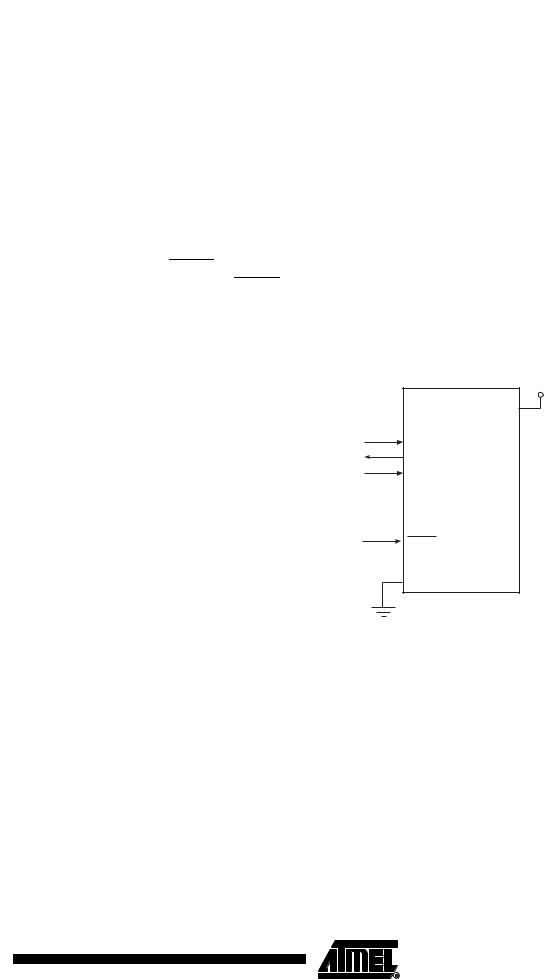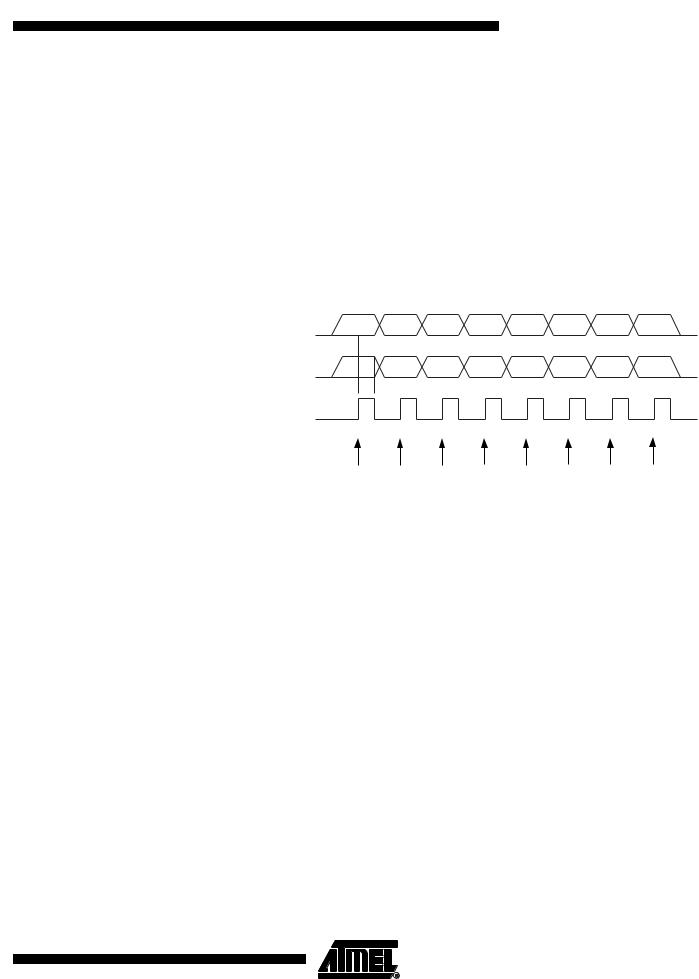
- •Features
- •1. Pin Configurations
- •2. Overview
- •2.1 Block Diagram
- •2.2 Automotive Quality Grade
- •2.3 Pin Descriptions
- •2.3.3 Port B (PB5..PB0)
- •2.3.4 RESET
- •3. About Code Examples
- •4. AVR CPU Core
- •4.1 Introduction
- •4.2 Architectural Overview
- •4.4 Status Register
- •4.5 General Purpose Register File
- •4.6 Stack Pointer
- •4.7 Instruction Execution Timing
- •4.8 Reset and Interrupt Handling
- •4.8.1 Interrupt Response Time
- •5. AVR ATtiny25/45/85 Memories
- •5.2 SRAM Data Memory
- •5.2.1 Data Memory Access Times
- •5.3 EEPROM Data Memory
- •5.3.1 EEPROM Read/Write Access
- •5.3.6 Atomic Byte Programming
- •5.3.7 Split Byte Programming
- •5.3.8 Erase
- •5.3.9 Write
- •5.3.10 Preventing EEPROM Corruption
- •5.4 I/O Memory
- •6. System Clock and Clock Options
- •6.1 Clock Systems and their Distribution
- •6.2 Clock Sources
- •6.3 Default Clock Source
- •6.4 Crystal Oscillator
- •6.6 Calibrated Internal RC Oscillator
- •6.7 External Clock
- •6.8 128 kHz Internal Oscillator
- •6.9 Clock Output Buffer
- •6.10 System Clock Prescaler
- •6.10.2 Switching Time
- •7. Power Management and Sleep Modes
- •7.1 Idle Mode
- •7.2 ADC Noise Reduction Mode
- •7.4 Power Reduction Register
- •7.5 Minimizing Power Consumption
- •7.5.1 Analog to Digital Converter
- •7.5.2 Analog Comparator
- •7.5.4 Internal Voltage Reference
- •7.5.5 Watchdog Timer
- •7.5.6 Port Pins
- •8. System Control and Reset
- •8.0.1 Resetting the AVR
- •8.0.2 Reset Sources
- •8.0.3 Power-on Reset
- •8.0.4 External Reset
- •8.0.6 Watchdog Reset
- •8.1 Internal Voltage Reference
- •8.2 Watchdog Timer
- •8.3 Timed Sequences for Changing the Configuration of the Watchdog Timer
- •8.3.1 Safety Level 1
- •8.3.2 Safety Level 2
- •9. Interrupts
- •9.1 Interrupt Vectors in ATtiny25/45/85
- •10. I/O Ports
- •10.1 Introduction
- •10.2 Ports as General Digital I/O
- •10.2.1 Configuring the Pin
- •10.2.2 Toggling the Pin
- •10.2.3 Switching Between Input and Output
- •10.2.4 Reading the Pin Value
- •10.2.5 Digital Input Enable and Sleep Modes
- •10.2.6 Unconnected Pins
- •10.3 Alternate Port Functions
- •10.3.2 Alternate Functions of Port B
- •11. External Interrupts
- •12. 8-bit Timer/Counter0 with PWM
- •12.1 Overview
- •12.1.1 Registers
- •12.1.2 Definitions
- •12.2 Timer/Counter Clock Sources
- •12.3 Counter Unit
- •12.4 Output Compare Unit
- •12.4.1 Force Output Compare
- •12.4.2 Compare Match Blocking by TCNT0 Write
- •12.4.3 Using the Output Compare Unit
- •12.5 Compare Match Output Unit
- •12.5.1 Compare Output Mode and Waveform Generation
- •12.6 Modes of Operation
- •12.6.1 Normal Mode
- •12.6.2 Clear Timer on Compare Match (CTC) Mode
- •12.6.3 Fast PWM Mode
- •12.6.4 Phase Correct PWM Mode
- •12.7 Timer/Counter Timing Diagrams
- •13. Timer/Counter Prescaler
- •13.0.1 Prescaler Reset
- •13.0.2 External Clock Source
- •14. 8-bit Timer/Counter1
- •14.1 Timer/Counter1
- •14.1.1 Timer/Counter1 Control Register - TCCR1
- •14.1.2 General Timer/Counter1 Control Register - GTCCR
- •14.1.3 Timer/Counter1 - TCNT1
- •14.1.4 Timer/Counter1 Output Compare RegisterA - OCR1A
- •14.1.5 Timer/Counter1 Output Compare RegisterB - OCR1B
- •14.1.6 Timer/Counter1 Output Compare RegisterC - OCR1C
- •14.1.7 Timer/Counter Interrupt Mask Register - TIMSK
- •14.1.8 Timer/Counter Interrupt Flag Register - TIFR
- •14.1.9 PLL Control and Status Register - PLLCSR
- •14.1.10 Timer/Counter1 Initialization for Asynchronous Mode
- •14.1.11 Timer/Counter1 in PWM Mode
- •15. 8-bit Timer/Counter1 in ATtiny15 Mode
- •15.1 Timer/Counter1 Prescaler
- •15.2 Timer/Counter1
- •15.2.2 Timer/Counter1 Control Register - TCCR1
- •15.2.3 General Timer/Counter1 Control Register - GTCCR
- •15.2.4 Timer/Counter1 - TCNT1
- •15.2.5 Timer/Counter1 Output Compare RegisterA - OCR1A
- •15.2.6 Timer/Counter1 Output Compare Register C - OCR1C
- •15.2.7 Timer/Counter Interrupt Flag Register - TIFR
- •15.2.8 PLL Control and Status Register - PLLCSR
- •15.2.9 Timer/Counter1 in PWM Mode
- •16. Dead Time Generator
- •16.0.1 Timer/Counter1 Dead Time Prescaler register 1 - DTPS1
- •16.0.2 Timer/Counter1 Dead Time A - DT1A
- •16.0.3 Timer/Counter1 Dead Time B - DT1B
- •17.1 Overview
- •17.2 Functional Descriptions
- •17.2.2 SPI Master Operation Example
- •17.2.3 SPI Slave Operation Example
- •17.2.5 Start Condition Detector
- •17.3 Alternative USI Usage
- •17.3.4 Edge Triggered External Interrupt
- •17.3.5 Software Interrupt
- •17.4 USI Register Descriptions
- •18. Analog Comparator
- •18.1 Analog Comparator Multiplexed Input
- •19. Analog to Digital Converter
- •19.1 Features
- •19.2 Operation
- •19.3 Starting a Conversion
- •19.4 Prescaling and Conversion Timing
- •19.5 Changing Channel or Reference Selection
- •19.5.1 ADC Input Channels
- •19.5.2 ADC Voltage Reference
- •19.6 ADC Noise Canceler
- •19.6.1 Analog Input Circuitry
- •19.6.2 Analog Noise Canceling Techniques
- •19.6.3 ADC Accuracy Definitions
- •19.7 ADC Conversion Result
- •19.7.1 Single Ended Conversion
- •19.7.2 Unipolar Differential Conversion
- •19.7.3 Bipolar Differential Conversion
- •19.7.4 Temperature Measurement (Preliminary description)
- •19.7.7.1 ADLAR = 0
- •19.7.7.2 ADLAR = 1
- •20. debugWIRE On-chip Debug System
- •20.1 Features
- •20.2 Overview
- •20.3 Physical Interface
- •20.4 Software Break Points
- •20.5 Limitations of debugWIRE
- •20.6 debugWIRE Related Register in I/O Memory
- •21. Self-Programming the Flash
- •21.0.1 Performing Page Erase by SPM
- •21.0.2 Filling the Temporary Buffer (Page Loading)
- •21.0.3 Performing a Page Write
- •21.1.2 EEPROM Write Prevents Writing to SPMCSR
- •21.1.3 Reading the Fuse and Lock Bits from Software
- •21.1.4 Preventing Flash Corruption
- •21.1.5 Programming Time for Flash when Using SPM
- •22. Memory Programming
- •22.1 Program And Data Memory Lock Bits
- •22.2 Fuse Bytes
- •22.2.1 Latching of Fuses
- •22.3 Signature Bytes
- •22.3.1 ATtiny25 Signature Bytes
- •22.3.2 ATtiny45 Signature Bytes
- •22.3.3 ATtiny85 Signature Bytes
- •22.4 Calibration Byte
- •22.5 Page Size
- •22.6 Serial Downloading
- •22.6.1 Serial Programming Algorithm
- •22.6.2 Serial Programming Characteristics
- •22.7 High-voltage Serial Programming
- •22.8.2 Considerations for Efficient Programming
- •22.8.3 Chip Erase
- •22.8.4 Programming the Flash
- •22.8.5 Programming the EEPROM
- •22.8.6 Reading the Flash
- •22.8.7 Reading the EEPROM
- •22.8.8 Programming and Reading the Fuse and Lock Bits
- •22.8.9 Reading the Signature Bytes and Calibration Byte
- •23. Electrical Characteristics
- •23.1 Absolute Maximum Ratings*
- •23.2 External Clock Drive Waveforms
- •23.3 External Clock Drive
- •23.5 Calibrated RC Oscillator Accuracy
- •24. Typical Characteristics
- •24.1 Active Supply Current
- •24.2 Idle Supply Current
- •24.2.1 Using the Power Reduction Register
- •24.2.1.1 Example 1
- •24.5 Pin Driver Strength
- •24.6 Pin Thresholds and Hysteresis
- •24.7 BOD Thresholds and Analog Comparator Offset
- •24.8 Internal Oscillator Speed
- •24.9 Current Consumption of Peripheral Units
- •24.10 Current Consumption in Reset and Reset Pulse width
- •24.11 Analog to Digital Converter
- •25. Register Summary
- •26. Instruction Set Summary
- •27. Ordering Information
- •28. Packaging Information
- •29. Document Revision History
- •30. Errata
- •30.1 ATtiny25/45/85 Rev. A

 ATtiny25/45/85 Auto
ATtiny25/45/85 Auto
Table 22-7. |
No. of Words in a Page and No. of Pages in the EEPROM |
|
||||
|
EEPROM |
|
|
|
|
|
Device |
Size |
Page Size |
PCWORD |
No. of Pages |
PCPAGE |
EEAMSB |
|
|
|
|
|
|
|
ATtiny25 |
128 bytes |
4 bytes |
EEA[1:0] |
32 |
EEA[6:2] |
6 |
|
|
|
|
|
|
|
ATtiny45 |
256 bytes |
4 bytes |
EEA[1:0] |
64 |
EEA[7:2] |
7 |
|
|
|
|
|
|
|
ATtiny85 |
512 bytes |
4 bytes |
EEA[1:0] |
128 |
EEA[8:2] |
8 |
|
|
|
|
|
|
|
22.6Serial Downloading
Both the Flash and EEPROM memory arrays can be programmed using the serial SPI bus while RESET is pulled to GND. The serial interface consists of pins SCK, MOSI (input) and MISO (output). After RESET is set low, the Programming Enable instruction needs to be executed first before program/erase operations can be executed. NOTE, in Table 22-8 on page 143, the pin mapping for SPI programming is listed. Not all parts use the SPI pins dedicated for the internal SPI interface.
Figure 22-1. Serial Programming and Verify(1)
+1.8 - 5.5V
VCC
MOSI
MISO
SCK
RESET
GND
Notes: 1. If the device is clocked by the internal Oscillator, it is no need to connect a clock source to the CLKI pin.
Table 22-8. Pin Mapping Serial Programming
Symbol |
Pins |
I/O |
Description |
|
|
|
|
MOSI |
PB0 |
I |
Serial Data in |
|
|
|
|
MISO |
PB1 |
O |
Serial Data out |
|
|
|
|
SCK |
PB2 |
I |
Serial Clock |
|
|
|
|
When programming the EEPROM, an auto-erase cycle is built into the self-timed programming operation (in the Serial mode ONLY) and there is no need to first execute the Chip Erase instruction. The Chip Erase operation turns the content of every memory location in both the Program and EEPROM arrays into 0xFF.
Depending on CKSEL Fuses, a valid clock must be present. The minimum low and high periods for the serial clock (SCK) input are defined as follows:
143
7598C–AVR–09/06

Low: > 2 CPU clock cycles for fck < 12 MHz, 3 CPU clock cycles for fck >= 12 MHz
High: > 2 CPU clock cycles for fck < 12 MHz, 3 CPU clock cycles for fck >= 12 MHz
22.6.1Serial Programming Algorithm
When writing serial data to the ATtiny25/45/85, data is clocked on the rising edge of SCK.
When reading data from the ATtiny25/45/85, data is clocked on the falling edge of SCK. See Figure 22-2 and Figure 22-3 for timing details.
To program and verify the ATtiny25/45/85 in the Serial Programming mode, the following sequence is recommended (see four byte instruction formats in Table 22-10):
1.Power-up sequence:
Apply power between VCC and GND while RESET and SCK are set to “0”. In some systems, the programmer can not guarantee that SCK is held low during power-up. In this case, RESET must be given a positive pulse of at least two CPU clock cycles duration after SCK has been set to “0”.
2.Wait for at least 20 ms and enable serial programming by sending the Programming Enable serial instruction to pin MOSI.
3.The serial programming instructions will not work if the communication is out of synchronization. When in sync. the second byte (0x53), will echo back when issuing the third byte of the Programming Enable instruction. Whether the echo is correct or not, all four bytes of the instruction must be transmitted. If the 0x53 did not echo back, give RESET a positive pulse and issue a new Programming Enable command.
4.The Flash is programmed one page at a time. The memory page is loaded one byte at a time by supplying the 5 LSB of the address and data together with the Load Program memory Page instruction. To ensure correct loading of the page, the data low byte must be loaded before data high byte is applied for a given address. The Program memory Page is stored by loading the Write Program memory Page instruction with the 6 MSB
of the address. If polling (RDY/BSY) is not used, the user must wait at least tWD_FLASH before issuing the next page. (See Table 22-9.) Accessing the serial programming interface before the Flash write operation completes can result in incorrect programming.
5.A: The EEPROM array is programmed one byte at a time by supplying the address and data together with the appropriate Write instruction. An EEPROM memory location is first automatically erased before new data is written. If polling (RDY/BSY) is not used,
the user must wait at least tWD_EEPROM before issuing the next byte. (See Table 22-9.) In a chip erased device, no 0xFFs in the data file(s) need to be programmed.
B: The EEPROM array is programmed one page at a time. The Memory page is loaded one byte at a time by supplying the 2 LSB of the address and data together with the Load EEPROM Memory Page instruction. The EEPROM Memory Page is stored by loading the Write EEPROM Memory Page Instruction with the 6 MSB of the address. When using EEPROM page access only byte locations loaded with the Load EEPROM Memory Page instruction is altered. The remaining locations remain unchanged. If poll-
ing (RDY/BSY) is not used, the used must wait at least tWD_EEPROM before issuing the next page (See Table 22-7). In a chip erased device, no 0xFF in the data file(s) need to
be programmed.
6.Any memory location can be verified by using the Read instruction which returns the content at the selected address at serial output MISO.
7.At the end of the programming session, RESET can be set high to commence normal operation.
144 ATtiny25/45/85 Auto 
7598C–AVR–09/06

ATtiny25/45/85 Auto
8.Power-off sequence (if needed): Set RESET to “1”.
Turn VCC power off.
Table 22-9. |
Minimum Wait Delay Before Writing the Next Flash or EEPROM Location |
|
Symbol |
|
Minimum Wait Delay |
|
|
|
tWD_FLASH |
|
4.5 ms |
tWD_EEPROM |
|
4.0 ms |
tWD_ERASE |
|
4.0 ms |
tWD_FUSE |
|
4.5 ms |
Figure 22-2. Serial Programming Waveforms
SERIAL DATA INPUT |
MSB |
LSB |
(MOSI) |
|
|
SERIAL DATA OUTPUT |
MSB |
LSB |
(MISO) |
|
|
SERIAL CLOCK INPUT |
|
|
(SCK) |
|
|
SAMPLE |
|
|
145
7598C–AVR–09/06

Table 22-10. Serial Programming Instruction Set
|
|
Instruction Format |
|
|
||
|
|
|
|
|
|
|
Instruction |
Byte 1 |
Byte 2 |
Byte 3 |
Byte4 |
Operation |
|
|
|
|
|
|
|
|
Programming Enable |
1010 |
0101 |
xxxx |
xxxx |
Enable Serial Programming |
|
1100 |
0011 |
xxxx |
xxxx |
after RESET goes low. |
||
|
||||||
|
|
|
|
|
|
|
Chip Erase |
1010 |
100x |
xxxx |
xxxx |
Chip Erase EEPROM and |
|
1100 |
xxxx |
xxxx |
xxxx |
Flash. |
||
|
||||||
|
|
|
|
|
|
|
Read Program |
0010 |
0000 |
bbbb |
oooo |
Read H (high or low) data o |
|
H000 |
000a |
bbbb |
oooo |
from Program memory at |
||
Memory |
||||||
|
|
|
|
word address a:b. |
||
|
|
|
|
|
||
|
|
|
|
|
|
|
|
0100 |
000x |
xxxb |
iiii |
Write H (high or low) data i to |
|
|
H000 |
xxxx |
bbbb |
iiii |
Program memory page at |
|
Load Program |
|
|
|
|
word address b. Data low |
|
Memory Page |
|
|
|
|
byte must be loaded before |
|
|
|
|
|
|
Data high byte is applied |
|
|
|
|
|
|
within the same address. |
|
|
|
|
|
|
|
|
Write Program |
0100 |
0000 |
bbxx |
xxxx |
Write Program memory Page |
|
Memory Page |
1100 |
000a |
xxxx |
xxxx |
at address a:b. |
|
|
|
|
|
|
|
|
Read EEPROM |
1010 |
000x |
xxbb |
oooo |
Read data o from EEPROM |
|
Memory |
0000 |
xxxx |
bbbb |
oooo |
memory at address b. |
|
|
|
|
|
|
|
|
Write EEPROM |
1100 |
000x |
xxbb |
iiii |
Write data i to EEPROM |
|
Memory |
0000 |
xxxx |
bbbb |
iiii |
memory at address b. |
|
|
|
|
|
|
|
|
Load EEPROM |
1100 |
0000 |
0000 |
iiii |
Load data i to EEPROM |
|
0001 |
0000 |
00bb |
iiii |
memory page buffer. After |
||
Memory Page (page |
||||||
|
|
|
|
data is loaded, program |
||
access) |
|
|
|
|
||
|
|
|
|
EEPROM page. |
||
|
|
|
|
|
||
|
|
|
|
|
|
|
Write EEPROM |
1100 |
00xx |
xxbb |
xxxx |
Write EEPROM page at |
|
Memory Page (page |
0010 |
xxxx |
bb00 |
xxxx |
||
address b. |
||||||
access) |
|
|
|
|
||
|
|
|
|
|
||
|
|
|
|
|
|
|
|
0101 |
0000 |
xxxx |
xxoo |
Read Lock bits. “0” = |
|
Read Lock bits |
1000 |
0000 |
xxxx |
oooo |
programmed, “1” = |
|
|
|
|
|
unprogrammed. See Table |
||
|
|
|
|
|
||
|
|
|
|
|
22-1 on page 140 for details. |
|
|
|
|
|
|
|
|
|
1010 |
111x |
xxxx |
11ii |
Write Lock bits. Set bits = “0” |
|
Write Lock bits |
1100 |
xxxx |
xxxx |
iiii |
to program Lock bits. See |
|
|
|
|
|
Table 22-1 on page 140 for |
||
|
|
|
|
|
||
|
|
|
|
|
details. |
|
|
|
|
|
|
|
|
Read Signature Byte |
0011 |
000x |
xxxx |
oooo |
Read Signature Byte o at |
|
0000 |
xxxx |
xxbb |
oooo |
address b. |
||
|
||||||
|
|
|
|
|
|
|
|
1010 |
1010 |
xxxx |
iiii |
Set bits = “0” to program, “1” |
|
Write Fuse bits |
1100 |
0000 |
xxxx |
iiii |
to unprogram. See Table 22- |
|
|
|
|
|
|
5 on page 141 for details. |
|
|
|
|
|
|
|
|
|
1010 |
1010 |
xxxx |
iiii |
Set bits = “0” to program, “1” |
|
Write Fuse High bits |
1100 |
1000 |
xxxx |
iiii |
to unprogram. See Table 22- |
|
|
|
|
|
|
4 on page 141 for details. |
|
|
|
|
|
|
|
|
Write Extended Fuse |
1010 |
1010 |
xxxx |
xxxx |
Set bits = “0” to program, “1” |
|
1100 |
0100 |
xxxx |
xxxi |
to unprogram. See Table 22- |
||
Bits |
||||||
|
|
|
|
3 on page 140 for details. |
||
|
|
|
|
|
||
|
|
|
|
|
|
|
146 ATtiny25/45/85 Auto 
7598C–AVR–09/06
